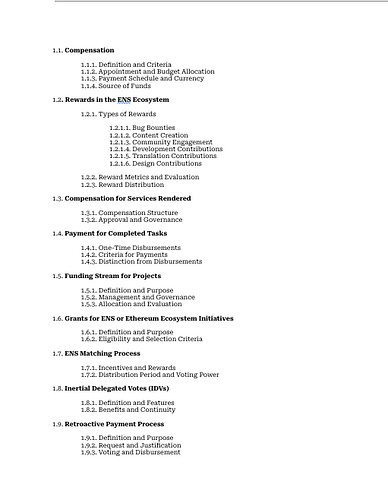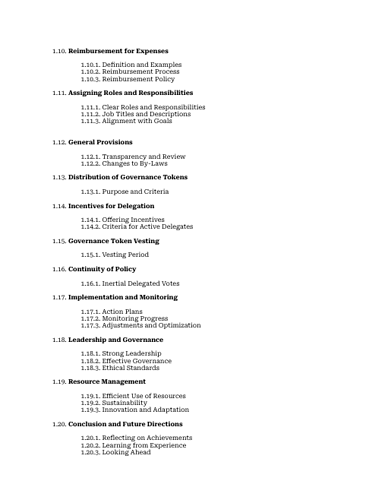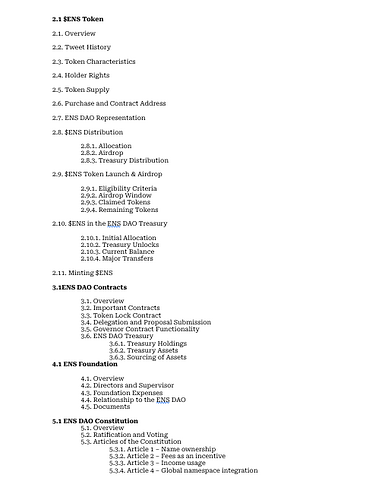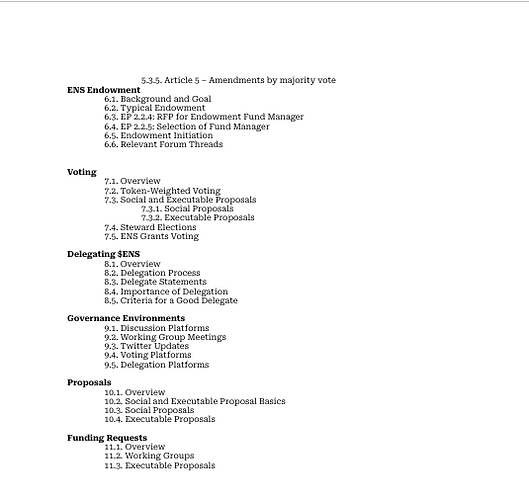I don’t really understand the rationale on locking up a reward that is retroactively disbursed to a member in which that member is already waiting to see benefit; post-action of their contribution.
I think we should a least be seeing some sort of framework by now …
In lieu of the further back and forth confusion of prioritizing areas off proposal conversation regarding:
Meta-Governance Budget Funding Request
Governance Distribution Program 2.0
Steward Vesting Proposal Temp Check Discussion
I believe we should take a step back for a second. We all need to be under same umbrella here. That means we need to ensure that out umbrella terms are used correctly because quite frankly–we are all from different cultures. Because of that, we are absolutely going to continue to run into to prolonged discussion and fumble over the semantic context of our financial understanding in this organization.
It seems like we are making conversation and then incorporating responses that state a perspective, method or reference to aspects of this organizations financial foundation without wholly and contextually placing technical reference to the root of such.
So I say we define the foundations of ENS’ Finance in clear terms to set precedence on future discussions in hopes that; as members, there shouldn’t be any contextual misunderstandings. This is especially important when monetary distributions, disbursements, payments or any other such transfer of funds from one entity to another.
Essentially, we are all here to assist each other in saving time for each other as well as millions of ENS users, right? We really, don’t have time to wait months for our standardized processes for reference because I can see we are all kinda looking around for a directive or formal reference for guidance on the right way
- ENS DAO Compensation and Guidelines
- 1.1. Compensation
- 1.1.1. Definition and Criteria
- 1.1.2. Appointment and Budget Allocation
- 1.1.3. Payment Schedule and Currency
- 1.1.4. Source of Funds
- 1.2. Rewards in the ENS Ecosystem
- 1.2.1. Types of Rewards
- 1.2.1.1. Bug Bounties
- 1.2.1.2. Content Creation
- 1.2.1.3. Community Engagement
- 1.2.1.4. Development Contributions
- 1.2.1.5. Translation Contributions
- 1.2.1.6. Design Contributions
- 1.2.2. Reward Metrics and Evaluation
- 1.2.3. Reward Distribution
- 1.3. Compensation for Services Rendered
- 1.3.1. Compensation Structure
- 1.3.2. Approval and Governance
- 1.4. Payment for Completed Tasks
- 1.4.1. One-Time Disbursements
- 1.4.2. Criteria for Payments
- 1.4.3. Distinction from Disbursements
- 1.5. Funding Stream for Projects
- 1.5.1. Definition and Purpose
- 1.5.2. Management and Governance
- 1.5.3. Allocation and Evaluation
- 1.6. Grants for ENS or Ethereum Ecosystem Initiatives
- 1.6.1. Definition and Purpose
- 1.6.2. Eligibility and Selection Criteria
- 1.7. ENS Matching Process
- 1.7.1. Incentives and Rewards
- 1.7.2. Distribution Period and Voting Power
- 1.8. Inertial Delegated Votes (IDVs)
- 1.8.1. Definition and Features
- 1.8.2. Benefits and Continuity
- 1.9. Retroactive Payment Process
- 1.9.1. Definition and Purpose
- 1.9.2. Request and Justification
- 1.9.3. Voting and Disbursement
- 1.10. Reimbursement for Expenses
- 1.10.1. Definition and Examples
- 1.10.2. Reimbursement Process
- 1.10.3. Reimbursement Policy
- 1.11. Assigning Roles and Responsibilities
- 1.11.1. Clear Roles and Responsibilities
- 1.11.2. Job Titles and Descriptions
- 1.11.3. Alignment with Goals
- 1.12. General Provisions
- 1.12.1. Transparency and Review
- 1.12.2. Changes to By-Laws
- 1.13. Distribution of Governance Tokens
- 1.13.1. Purpose and Criteria
- 1.14. Incentives for Delegation
- 1.14.1. Offering Incentives
- 1.14.2. Criteria for Active Delegates
- 1.15. Governance Token Vesting
- 1.16. Continuity of Policy
- 1.16.1. Inertial Delegated Votes
- 1.17. Implementation and Monitoring
- 1.17.1. Action Plans
- 1.17.2. Monitoring Progress
- 1.17.3. Adjustments and Optimization
- 1.18. Leadership and Governance
- 1.18.1. Strong Leadership
- 1.18.2. Effective Governance
- 1.18.3. Ethical Standards
- 1.19. Resource Management
- 1.19.1. Efficient Use of Resources
- 1.19.2. Sustainability
- 1.19.3. Innovation and Adaptation
- 1.20. Conclusion and Future Directions
- 1.20.1. Reflecting on Achievements
- 1.20.2. Learning from Experience
- 1.20.3. Looking Ahead
- $ENS Token
- 2.1. Overview
- 2.2. Tweet History
- 2.3. Token Characteristics
- 2.4. Holder Rights
- 2.5. Token Supply
- 2.6. Purchase and Contract Address
- 2.7. ENS DAO Representation
- 2.8. $ENS Distribution
- 2.8.1. Allocation
- 2.8.2. Airdrop
- 2.8.3. Treasury Distribution
- 2.9. $ENS Token Launch & Airdrop
- 2.9.1. Eligibility Criteria
- 2.9.2. Airdrop Window
- 2.9.3. Claimed Tokens
- 2.9.4. Remaining Tokens
- 2.10. $ENS in the ENS DAO Treasury
- 2.10.1. Initial Allocation
- 2.10.2. Treasury Unlocks
- 2.10.3. Current Balance
- 2.10.4. Major Transfers
- 2.11. Minting $ENS
- ENS DAO Contracts
- 3.1. Overview
- 3.2. Important Contracts
- 3.3. Token Lock Contract
- 3.4. Delegation and Proposal Submission
- 3.5. Governor Contract Functionality
- 3.6. ENS DAO Treasury
- 3.6.1. Treasury Holdings
- 3.6.2. Treasury Assets
- 3.6.3. Sourcing of Assets
- ENS Foundation
- 4.1. Overview
- 4.2. Directors and Supervisor
- 4.3. Foundation Expenses
- 4.4. Relationship to the ENS DAO
- 4.5. Documents
- ENS DAO Constitution
- 5.1. Overview
- 5.2. Ratification and Voting
- 5.3. Articles of the Constitution
- 5.3.1. Article 1 – Name ownership
- 5.3.2. Article 2 – Fees as an incentive
- 5.3.3. Article 3 – Income usage
- 5.3.4. Article 4 – Global namespace integration
- 5.3.5. Article 5 – Amendments by majority vote
- ENS Endowment
- 6.1. Background and Goal
- 6.2. Typical Endowment
- 6.3. EP 2.2.4: RFP for Endowment Fund Manager
- 6.4. EP 2.2.5: Selection of Fund Manager
- 6.5. Endowment Initiation
- 6.6. Relevant Forum Threads
- Voting
- 7.1. Overview
- 7.2. Token-Weighted Voting
- 7.3. Social and Executable Proposals
- 7.3.1. Social Proposals
- 7.3.2. Executable Proposals
- 7.4. Steward Elections
- 7.5. ENS Grants Voting
- Delegating $ENS
- 8.1. Overview
- 8.2. Delegation Process
- 8.3. Delegate Statements
- 8.4. Importance of Delegation
- 8.5. Criteria for a Good Delegate
- Governance Environments
- 9.1. Discussion Platforms
- 9.2. Working Group Meetings
- 9.3. Twitter Updates
- 9.4. Voting Platforms
- 9.5. Delegation Platforms
- Proposals
- 10.1. Overview
- 10.2. Social and Executable Proposal Basics
- 10.3. Social Proposals
- 10.4. Executable Proposals
- Funding Requests
- 11.1. Overview
- 11.2. Working Groups
- 11.3. Executable Proposals
or perhaps something similar to:
which should yeiled content such as a standardization that is not only applicable to ENS DAO Specifically but also has the ability to be used by other organizations as their own standard as well.
for example:
1.2 Compensation
1.2.1 Definition
Compensation refers to the process of regularly scheduled disbursements made in USDC for services which have already been rendered and expected to be rendered within a specified time period pertinent to a specific position. Compensation is subject to DAO approval and is usually associated with ongoing roles or obligations within the DAO, such as those of stewards or service providers.
1.2.2 Structure
The compensation structure in DAOs is designed to promote fairness, transparency, and alignment with the organization’s goals. It is usually determined through a combination of factors such as the individual’s experience, skills, the scope of work, and the overall budget of the DAO. Compensation packages may include a base salary, performance-based incentives, and benefits such as health insurance or access to educational resources.
1.2.3 Approval Process
Compensation in DAOs is subject to approval by the DAO’s governance structure, ensuring transparency and accountability in the allocation of funds. By providing regular compensation, DAOs ensure that contributors are adequately rewarded for their efforts and that the organization can attract and retain talented individuals who are committed to its mission.
1.3 Payment
1.3.1 Definition
Payment refers to a one-time disbursement in United States Dollar-Collateralized (USDC) effectuated in consideration for a completed task. Payments are not subject to continuous disbursement unless expressly provided for in a contingency-based contractual arrangement and must meet clearly1.2.3 Reward Distribution
Rewards are typically expressed in USDC, a stablecoin pegged to the US dollar, to ensure transparency and fairness in their distribution. The amount of each reward is determined based on the pre-established standard metrics set by the ENS DAO.
1.2.3.1 Evaluation Criteria
The specific metrics used to evaluate and determine the value of contributions are established by the ENS DAO. These metrics may include factors such as the impact of the contribution on the ENS ecosystem, the level of effort and expertise required, and the overall quality and uniqueness of the work.
1.2.3.2 Funding Sources
Rewards are funded from various sources within the ENS ecosystem, such as the ENS treasury, community donations, or partnerships with external organizations. This funding ensures that there are sufficient resources available to recognize and incentivize valuable contributions from community members.
1.2.3.3 Governance and Transparency
To maintain transparency and accountability, the ENS DAO typically follows a structured and documented process for evaluating and awarding rewards. This process may involve community input, peer review, and final approval by the DAO’s governance body.
1.3 Compensation
1.3.1 Regular Disbursements
Compensation is the process of regularly scheduled disbursements made in USDC for services that have already been rendered and are expected to be rendered within a specified time period pertinent to a specific position. Compensation is subject to DAO approval and is usually associated with ongoing roles or obligations within the DAO, such as those of stewards or service providers.
1.3.2 Compensation Structure
The compensation structure in DAOs is designed to promote fairness, transparency, and alignment with the organization’s goals. It is usually determined through a combination of factors such as the individual’s experience, skills, the scope of work, and the overall budget of the DAO. Compensation packages may include a base salary, performance-based incentives, and benefits such as health insurance or access to educational resources.
1.3.3 Approval and Governance
Compensation in DAOs is subject to approval by the DAO’s governance structure, ensuring transparency and accountability in the allocation of funds. By providing regular compensation, DAOs ensure that contributors are adequately rewarded for their efforts and that the organization can attract and retain talented individuals who are committed to its mission.
1.4 Payment
1.4.1 One-Time Disbursements
Payment refers to a one-time disbursement in United States Dollar-Collateralized (USDC) effectuated in consideration for a completed task. Payments are not subject to continuous disbursement unless expressly provided for in a contingency-based contractual arrangement and must meet clearly defined requirements.
1.4.2 Criteria for Payments
A disbursement is classified as a payment if it meets specific criteria, such as occurring no more than three times in a calendar quarter or once per month on the same calendar day as the initial disbursement. This ensures that payments are not made too frequently and are consistent with the definition of a one-time payment.
1.4.3 Distinction from Disbursements
The distinction between payments and disbursements is important for ensuring that payments are made in a timely and consistent manner, preventing duplicate payments or overpayments, and accurately tracking and managing financial transactions.
1.5 Funding Streams
1.5.1 Definition and Purpose
A Funding Stream is a pool of funds allocated in USDC for projects endorsed by the DAO. These funds are then distributed among candidates that provide services to the DAO or contribute to the continued development of the ENS ecosystem. The purpose of the Funding Stream is to ensure that there is a sustainable source of funding for projects that are important to the DAO and the ENS ecosystem.
1.5.2 Management and Governance
The Funding Stream is managed by the Meta-Gov Working Group and all funding decisions are made by the DAO community through a governance process. This process ensures that the funds are used in a transparent and accountable manner. The Funding Stream is used to fund a variety of projects, including development, outreach, education, community events, and research and development.
1.5.3 Allocation and Evaluation
The Funding Stream is allocated a specific amount of USDC each year. The DAO community can propose projects to be funded through the Funding Stream. Projects are evaluated by the DAO community and then voted on. The projects that receive the most votes are funded.
1.6 Grant
1.6.1 Definition and Purpose
A Grant is a one-time disbursement in USDC for initiatives that benefit the ENS or Ethereum ecosystem. These one-time grants are used to support projects that are working to improve the ENS or Ethereum ecosystem in some way. Grants are determined by the working groups that distribute them through a program available for submission by any persons or projects.
1.6.2 Eligibility and Selection Criteria
Any person or project can apply for a grant. However, projects that are already receiving funding from other sources may not be eligible. Grants are awarded based on several criteria, including the project’s potential impact, feasibility, and the team’s experience.
etc etc



